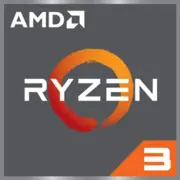AMD Ryzen 3 4300G

AMD Ryzen 3 4300G: Budget Processor with Integrated Graphics for 2025
April 2025
Key Features: Zen 2 in a Compact Format
The AMD Ryzen 3 4300G processor, released in 2020, remains relevant in the budget segment thanks to its successful combination of price and performance.
- Architecture and Process Technology: Based on the Zen 2 microarchitecture and manufactured using a 7nm process technology. This ensures low power consumption (TDP 65W) and decent performance in multi-threaded tasks.
- Cores and Frequencies: 4 cores and 8 threads with a base clock of 3.8 GHz and turbo up to 4 GHz. This is sufficient for office tasks and light gaming.
- Cache and Graphics: 4 MB L3 cache and integrated Radeon Vega 6 graphics (presumably). The graphics handle Full HD in less demanding games, such as CS:GO (60-90 FPS on low settings).
- Geekbench 6: 1507 points (single-core) and 5071 points (multi-core). This is on par with the Intel Core i5-10400, but in a more compact form factor.
Compatible Motherboards: AM4 as the Standard
The Ryzen 3 4300G uses the AM4 socket, opening access to a wide range of motherboards:
- Chipsets: A520 (budget), B550 (optimal choice), X570 (premium). For most users, the B550 is sufficient — it supports PCIe 4.0 (if a discrete graphics card is used), USB 3.2 Gen 2.
- Examples of Motherboards:
- ASUS Prime B550M-A (from $90): A reliable option with two M.2 slots.
- MSI A520M-A Pro (from $70): A minimalist motherboard for office builds.
- Important: Check the compatibility list on the manufacturer's website before purchase. Some motherboards may require a BIOS update.
Memory: DDR4 in Dual-Channel Mode
The processor supports DDR4 but not DDR5. Recommendations:
- Frequency: 3200 MHz is the optimal choice for Zen 2. Overclocking to 3600 MHz is possible but not guaranteed.
- Configuration: Dual-channel mode (2×8 GB) for maximum performance. For gaming and multitasking, a minimum of 16 GB is recommended.
- Example: A Corsair Vengeance LPX 16 GB kit (2×8 GB) DDR4-3200 costs about $50.
Power Supply: 400–500W for Stability
The processor itself consumes up to 65W, but when building with room for upgrades:
- Integrated Graphics: A 400W PSU (e.g., EVGA 400 W1, $40) is sufficient for a system without a discrete graphics card.
- With a Discrete GPU: For RX 6600 or RTX 3050, a 500–550W PSU is required (Corsair CX550, $60).
- Certification: Choose models with 80 Plus Bronze or higher for reliability.
Pros and Cons of Ryzen 3 4300G
Pros:
- Price: The new processor costs $120–130 (as of April 2025), which is cheaper than the Intel Core i3-13100 ($150).
- Energy Efficiency: Ideal for compact PCs and HTPCs.
- Graphics: Vega 6 allows for gaming without a discrete graphics card.
Cons:
- 4 Cores: In 2025, this is the minimum standard. Multi-threaded tasks (rendering, streaming) will be challenging.
- No PCIe 4.0 on A520: Limits NVMe drive speeds.
Use Cases: Who is This Processor For?
1. Office and Multimedia: Smooth operation with browsers, Office applications, YouTube 4K.
2. Light Gaming: Dota 2, Minecraft, GTA V (on low settings at Full HD).
3. Home Server: Low power consumption and support for virtualization.
4. Educational Projects: Programming, basic Photoshop work.
Comparison with Competitors
- Intel Core i3-13100 (4 cores/8 threads):
- Pros: Higher IPC, supports DDR5.
- Cons: More expensive ($150), no integrated graphics in some variants.
- AMD Ryzen 5 4600G (Zen 2, 6 cores):
- Pros: More cores (6/12), Vega 7.
- Cons: Price of $170, higher TDP.
Conclusion: The Ryzen 3 4300G excels in the budget segment due to its price and integrated graphics.
Build Tips
1. Motherboard: Choose B550 for PCIe 4.0 and future upgrades to Ryzen 5000.
2. Cooling: The stock cooler is sufficient, but for quieter operation, consider the DeepCool GAMMAXX 400 ($25).
3. Storage: An NVMe SSD (e.g., Kingston NV2 500GB, $45) will speed up system boot times.
4. Case: Micro-ATX with good ventilation (Cooler Master MasterBox Q300L, $55).
Conclusion: Who is the Ryzen 3 4300G Suitable For?
This processor is an ideal choice for:
- Budget Users: Building a PC under $500.
- Office Systems: Reliability and low operational costs.
- Upgrade Enthusiasts: A temporary solution with future plans (e.g., installing a Ryzen 7 5700X).
If you need a PC for everyday tasks, media consumption, and light gaming without investing in a graphics card, the Ryzen 3 4300G remains a cost-effective option even in 2025.
Basic
CPU Specifications
Memory Specifications
GPU Specifications
Benchmarks
Compared to Other CPU
Share in social media
Or Link To Us
<a href="https://cputronic.com/en/cpu/amd-ryzen-3-4300g" target="_blank">AMD Ryzen 3 4300G</a>